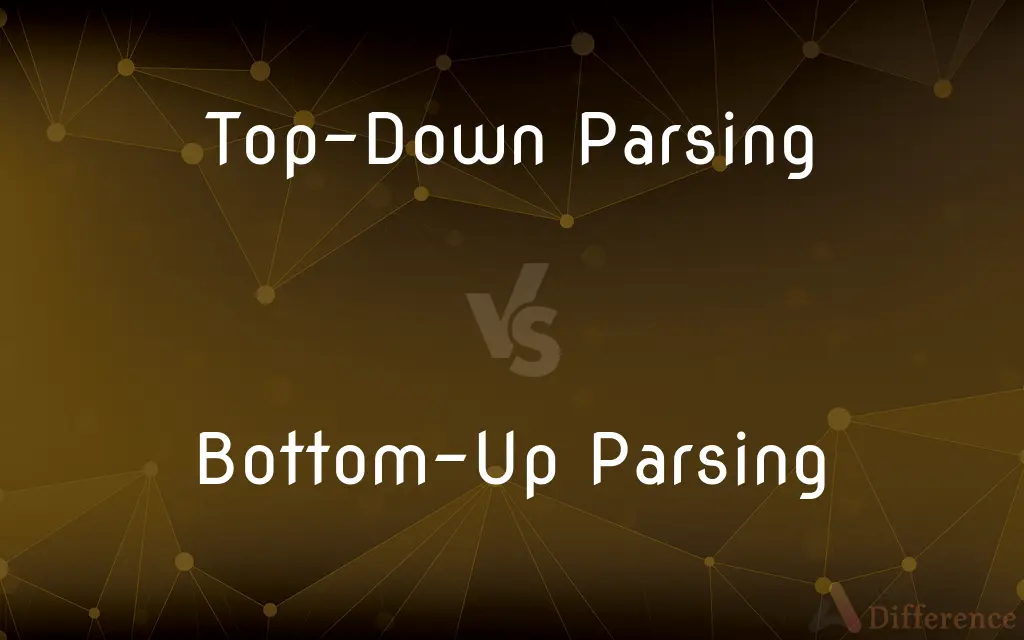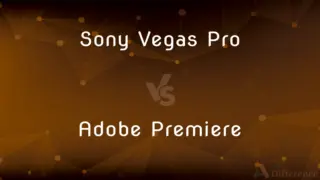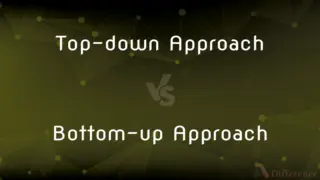Top-Down Parsing vs. Bottom-Up Parsing — What's the Difference?
By Tayyaba Rehman — Published on January 5, 2024
Top-Down Parsing begins analysis from the highest level of a hierarchical structure, breaking it into smaller components. Bottom-Up Parsing starts with smaller units, gradually building up to the higher-level structure in a step-by-step manner.

Difference Between Top-Down Parsing and Bottom-Up Parsing
Table of Contents
ADVERTISEMENT
Key Differences
Top-Down Parsing, an approach to parsing, starts with the topmost, broader structure of a language and decomposes it into smaller constituents. Bottom-Up Parsing, another parsing technique, begins with the smallest units and constructs the higher-level structure incrementally.
In Top-Down Parsing, the parser starts from the root of the syntax tree and recursively breaks it into smaller substructures until reaching individual terminal symbols. Bottom-Up Parsing starts from individual terminal symbols and combines them step-by-step to build higher-level structures until reaching the root.
Top-Down Parsing techniques, like LL and recursive descent, analyze input based on a set of grammar rules, breaking down the structure from higher levels to lower levels. Bottom-Up Parsing methods, such as LR parsing, build structures by combining smaller elements progressively until reaching the top-level structure.
Top-Down Parsing relies on production rules and tries to match the input to these rules, working from a high-level view to lower levels. Bottom-Up Parsing uses shift-reduce operations, constructing the syntax tree gradually from individual tokens upward to the higher-level structure.
Bottom-Up Parsing typically generates shift-reduce actions, working bottom-up to construct the parse tree, while Top-Down Parsing uses recursive descent, starting from the root and navigating downward to identify constituents.
ADVERTISEMENT
Comparison Chart
Starting Point
Begins from the highest level, top of the syntax tree
Starts from individual tokens, lowest level, builds upward
Process Flow
Decomposes structure from top to bottom
Constructs structure incrementally from bottom to top
Techniques
Utilizes LL, recursive descent parsing methods
Employs LR parsing methods, shift-reduce operations
Grammar Usage
Matches input based on grammar rules
Generates shift-reduce actions to form the parse tree
Approach
Works from a high-level view downward
Constructs from lower-level units upward to higher structures
Compare with Definitions
Top-Down Parsing
Breaks down syntax from broad to specific.
The parser in Top-Down Parsing breaks structures into smaller constituents.
Bottom-Up Parsing
Generates shift-reduce actions for parsing.
Shift-reduce operations are part of Bottom-Up Parsing to build the syntax tree.
Top-Down Parsing
Analyzes language structure from top to bottom.
Top-Down Parsing starts with the highest-level structure.
Bottom-Up Parsing
Starts from terminals, progresses to higher structures.
Bottom-Up Parsing begins parsing from tokens and moves upward to higher-level structures.
Top-Down Parsing
Begins parsing from the root of the syntax tree.
In Top-Down Parsing, analysis starts from the root and progresses downward.
Bottom-Up Parsing
Constructs language structure from smaller units.
Bottom-Up Parsing builds structures by combining smaller constituents.
Top-Down Parsing
Utilizes LL parsing methods for analysis.
LL parsing is a technique used in Top-Down Parsing for syntax analysis.
Bottom-Up Parsing
Employs LR parsing techniques for analysis.
LR parsing is a method utilized in Bottom-Up Parsing for syntax recognition.
Top-Down Parsing
Applies recursive descent for syntax analysis.
Recursive descent is a method employed in Top-Down Parsing for structural breakdown.
Bottom-Up Parsing
Builds structure incrementally, bottom to top.
In Bottom-Up Parsing, the syntax tree grows from individual tokens.
Common Curiosities
How does Bottom-Up Parsing build the syntax tree?
Bottom-Up Parsing uses shift-reduce actions, starting from individual tokens and combining them to build the syntax tree gradually.
What is the advantage of Top-Down Parsing?
Top-Down Parsing allows a clearer understanding of the high-level structure of a language before delving into details, aiding in language comprehension.
What is the primary principle behind Bottom-Up Parsing?
Bottom-Up Parsing constructs the syntax tree by starting with individual tokens and incrementally combining them to form higher-level structures.
What parsing techniques are commonly used in Top-Down Parsing?
Techniques like LL parsing and recursive descent are commonly employed in Top-Down Parsing to analyze the syntax of languages.
How does Top-Down Parsing identify language structures?
Top-Down Parsing follows grammar rules to match input, breaking down the structure based on predefined rules.
What happens if Top-Down Parsing encounters a parsing conflict?
Parsing conflicts might arise in Top-Down Parsing, leading to difficulties in determining the correct parsing path without additional resolution strategies.
How does Top-Down Parsing differ from Bottom-Up Parsing?
Top-Down Parsing starts analysis from the topmost structure, while Bottom-Up Parsing starts from individual tokens, building up the structure incrementally.
Can Bottom-Up Parsing handle left-recursive grammars?
Yes, Bottom-Up Parsing, especially LR parsing, can handle left-recursive grammars by constructing the syntax tree efficiently.
Can Top-Down Parsing handle ambiguous grammars?
Top-Down Parsing might struggle with ambiguous grammars as it aims to follow a specific path from top to bottom, potentially leading to parsing conflicts.
What is the significance of LR parsing in Bottom-Up Parsing?
LR parsing, used in Bottom-Up Parsing, allows recognizing the leftmost derivation of a grammar, aiding in constructing the syntax tree.
What advantages does Bottom-Up Parsing offer over Top-Down Parsing?
Bottom-Up Parsing is more flexible, handling ambiguous grammars and generating the syntax tree without strict adherence to a predefined structure.
Why is Bottom-Up Parsing considered more flexible?
Bottom-Up Parsing allows parsing even if the grammar is ambiguous or not explicitly defined, providing flexibility in analysis.
Is Top-Down Parsing suitable for all types of grammars?
Top-Down Parsing might struggle with left-recursive grammars and some forms of ambiguity, impacting its suitability for all grammatical structures.
Does Top-Down Parsing have any limitations in handling complex grammatical structures?
Top-Down Parsing might face limitations in handling highly complex grammars, especially those with significant ambiguity or recursive structures.
How does Bottom-Up Parsing resolve parsing conflicts?
Bottom-Up Parsing employs shift-reduce and reduce-reduce strategies to handle parsing conflicts and construct the syntax tree accurately.
Share Your Discovery

Previous Comparison
Sony Vegas Pro vs. Adobe Premiere
Next Comparison
Top-down Approach vs. Bottom-up ApproachAuthor Spotlight
Written by
Tayyaba RehmanTayyaba Rehman is a distinguished writer, currently serving as a primary contributor to askdifference.com. As a researcher in semantics and etymology, Tayyaba's passion for the complexity of languages and their distinctions has found a perfect home on the platform. Tayyaba delves into the intricacies of language, distinguishing between commonly confused words and phrases, thereby providing clarity for readers worldwide.














































